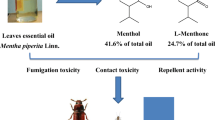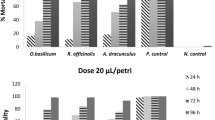Abstract
The essential oils of two medicinal plants from yarrow (Achillea wilhelmsii L.) and sweet asafetida (Ferula assa-foetida L.) were studied for fumigant toxicity, contact toxicity and repellent activity against two-day old nymphs of Aphis gossypii Glover. The mortality increased with increase of concentration and exposure time from 12 to 24 h in fumigant toxicity and from 24 to 48 h in contact toxicity. After 12 h, the LC50 values in fumigant toxicity of A. wilhelmsii and F. assa-foetida essential oils were estimated to be 23.4 and 16.8 µl l− 1 air respectively, and the toxicity was increased after 24 h to LC50 of 16.16 and 15.10 µl l− 1 air. LC50 values in contact toxicity of yarrow and sweet asafetida essential oils were estimated 6620and 2040 µl l− 1 after 24 h and 2478 and 882 µl l− 1 after 48 h, respectively. Furthermore, repellent activity was observed for all essential oils at the highest concentration (10 µl ml− 1). The structure of the essential oil was analysed by (GC/MS). The highest components were (E)-1-propenyl sec-butyl disulfide (43.16%) and (Z)-1-propenyl sec-butyl disulfide (27.45) in sweet asafetida; camphore (29.03%) and 1,8-Cineole (12.86%) in Yarrow, which are compounds that possess insecticidal activity against various insect species. Results from this research could be a basic and essential step for application of present plant materials as a potential substitution of chemical insecticides for control of A. gossypii.


Similar content being viewed by others
Availability of Data and Material
The authors state that data supporting the results of this study are existing within the article (and its supplementary information file).
Code Availability
Not applicable.
References
Adams RP (1995) Identification of essential oil components by gas chromatography/ mass spectrometry. Allured Publishing Corporation, Carol Stream, Illinois, USA, p 455
Adams AJ, Hall FR, Hoy CW (1990) Evaluating resistance to permethrin in Plutella xylostella (Lepidoptera: Plutellidae) population using uniformly sized droplets. J Econ Entomol 83(4):1211–1215
Bakkali F, Averbeck S, Averbeck D, Idaomar M (2008) Biological effects of essential oils-a review. J Food Chem & Toxicol 46:446–475
Batish DR, Singh HP, Kohli RK, Kaur S (2008) Eucalyptus essential oil as a natural pesticide. For Ecol Manag 256:2166–2174
Daoubi M, Macias A, Hermamdez R, Hitchcoch P, Hanson J, Collado I (2005) Antifungal activity and biotransmation of disophorone by Botrytis cinerea. J Agric & Food Chem 53:6035–6039
Erler F, Ulug I, Yalcinkaya B (2006) Repellent activity of five essential oils against Culex pipiens. Fitoterapia 77:491–494
Ghasemi V, Moharramipour S, Tahmasbi G (2011) Biological activity of some plant essential oils against Varroa destructor (Acari: Varroidae), an ectoparasitic mite of Apis mellifera (Hymenoptera: Apidae). Exp Appl Acarol 55:147–154
Iran Herbal Pharmakopeh Edition Committee (2002) Iran Herbal Pharmakopeh. Ministry of Health & Medical Education, Food and Medicine Deputy Office Publication. pp. 795
Isman MB (2000) Plant essential oils for pest and disease management. Crop Prot 19:603–608
Isman MB (2006) Botanical insecticides, deterrents and repellents in modern agriculture and an increasingly regulated world. Annu Rev Entomol 51:45–66
Isman MB (2008) Perspective botanical insecticides: For richer, for poorer. Pest Manag Sci 64:8–11
Isman MB (2020) Commercial development of plant essential oils and their constituents as active ingredients in bioinsecticides.Phytochem Rev1–7
Isman MB, Machial CM, Miresmailli S, Bainard LD (2007) Essential oil-based pesticides: New isights from old chemistry. In the Book: Pesticide Chemistry (eds. Hideo Ohkawa, Hisashi Miyagawa, Philip W. Lee), Print ISBN: 9783527316632, Wiley-VCH Verlag GmbH and Co
Jiang H, Wang J, Song L, Cao X, Yao X, Tang F, Yue Y (2016) GCxGC-TOFMS Analysis of essential oils composition from leaves, twigs and seeds of Cinnamomum camphora L. presl and their insecticidal and repellent activities. Molecules 21:423–435
Ketoh GK, Koumaglo HK, Glitho A (2005) Inhibition of Callosobruchus maculatus F. (Coleoptera: Bruchidae) development with essential oil extracted from Cymbopogon schoenantus L. Spreng. (Poaceae), and the wasp Dinarmus basalis (Rondani) (Hymenoptera: Pteromalidae). J Stored Prod Res 41: 363–371
Khani A, Asghari J (2012) ) Insecticide activity of essential oils of Mentha longifolia, Pulicaria gnaphalodes and Achillea wilhelmsii against two stored product pests, the flour beetle, Tribolium castaneum, and the cowpea weevil, Callosobruchus maculatus. J Insect Sci, 12 (1): 73–78
Kim JC, Kim KJ, Kim DS, Han JS (2005) Seasonal variations of monoterpene emissions from coniferous trees of different ages in Korea. Chemosphere 59:1685–1696
Koorki Z, Shahidi-Noghabi S, Mahdian K, Pirmaoradi MR (2018) Chemical composition and insecticidal properties of several plant essential oils on the melon aphid, Aphis gossypii Glover (Hemiptera: Aphididae). J Essent Oil Bear Pl 21:420–429
Kumar V, Mathela CS (2017) Toxicity and repellent effect of essential oils and a major component against Lipaphis erysimi. J Crop Prot 6:15–23
Lee BH, Annis PC, Tumaalii F, Choi WC (2004) Fumigant toxicity of essential oils from the Myrtaceae family and 1, 8-cineole against 3 major stored-grain insects. J Stored Prod Res 40:553–564
Leora Software (2008) Polo-Plus A user guide to probit or logit analysis. LeOra Software, Berkeley, CA
Miquel J, Richard H, Sandret F (1976) Volatile constituent of Morrocan thyme oil. J Agric & Food Chem 24(4):833–835
Miresmailli S, Bradbury R, Isman MB (2006) Comparative toxicity of Rosmarinus officinalis L. essential oil and blends of its major constituents against Tetranychus urticae Koch (Acari: Tetranychidae) on two different host Plants. Pest Manag Sci 62:366–371
Mozaffarian V (2004) A dictionary of Iranian plant names. Tehran, Farhange Moaser
Nemeth E (2005) Essential oil composition of species in the genus Achillea. J Essent Oil Res 17:501–512
Ogendo JO, Kostyukovsky M, Ravid U, Matasyoh JC, Deng AL (2008) Bioactivity of Ocimum gratissimum L. oil and two of its constituents against five insect pests attacking stored food products. J Stored Prod Res 44:328–334
Papachristos DP, Stamopoulos DC (2002) Repellent, toxic and reproduction inhibitory effects of essential oil vapours on Acanthoscelides obtectus (Say) (Coleoptera: Bruchidae). J Stored Prod Res 38:117–128
Pavela R (2009) Larvicidal effects of some Euro-Asiatic plants against Culex quinquefasciatus Say larvae (Diptera: Culicidae). Parasitol Res 105:887–892
Phillips AK, Appel AG (2010) Fumigant toxicity of essential oils to the German Cock roach (Dictyoptera: Blattellidae). J Econ Entomol 103(3):781–790
Poorjavad N, Goldansaz SH, Dadpour H, hajehali J (2014) Effect of Ferula assafoetida essential oil on some biological and behavioral traits of Trichogramma embryophagum and T. evanescens. Bio Control 59:403–413
Robertson JL, Preisler HK, Russell RM (2007) PoloPlus: Probit and Logit analysis user’s guide. LeOra Software, Petaluna (CA)
Roditakis E, Roditakis NE, Tsagkarakou A (2005) Insecticide resistance in Bemisia tabaci (Homoptera: Aleyrodidae) populations from Crete. Pest Manag Sci 61:577–582
Ruffinengo S, Eguaras M, Floris I, Faverin C, Bailac P, Ponzi M (2005) LD50 and repellent effects of essential oils from Argentinean wild plants species on Varroa destructor. J Econ Entomol 98:651–655
Shekari M, Jalali Sendi J, Etebari K, Zibaee A, Shadparvar A (2008) Effect of Artemisia annua L. (Asteracea) on nutritional physiology and enzyme activities of elm leaf beetle, Xanthogaleruca luteola Mull. (Colepotera: Chrysomellidae). Pestic Biochem Physiol 91: 66–74
Shrestha RB, Parajulee MN (2013) Potential cotton aphid, Aphis gossypii, population suppression by arthropod predators in upland cotton. Insect Sci 20:778–788
Stevens M, Lacomme C (2017) Transmission of plant viruses. In: van Emden HF, Harrington R (eds) Aphids as crop pests. CABI, Wallingford, UK, pp 323–361
Tripathi AK, Prajapati V, Aggarwal KK, Kumar S (2001) Toxicity, Feeding deterrence and effect of activity of 1, 8 cineole from Artemisia annua on progeny production of Tribolium casteneum (Coleoptera: Tenebrionidae). J Econ Entomol 94:979–983
Vandenborre G, Van Damme EJM, Smagghe G (2009) Nicotiana tabacum agglutinin expression in response to different biotic challengers. Arthropod Plant Interact 3:193–202
Waliwitiya R, Isman BM, Vernon RS, Riseman A (2005) Insecticidal activity of selected monoterpenoids and rosemary oil to Agriotes obscurus (Coleoptera: Elateridae). J Econ Entomol 98:1560–1565
Yang YC, Choi HC, Choi WS, Clark JM, Ahn YJ (2004) Ovicidal and adulticidal activity of Eucalyptus globulus leaf oil terpenoids against Pediculus humanus capitis (Anoplura: Pediculidae). J Agric Food Chem 52:2507–2511
Yoon C, Moon SR, Jeong JW, Shin YH, Cho SR, Ahn KS, Yang JO, Kim GH (2011) Repellency of lavender oil and linalool against spot clothing wax cicada, Lycorma delicatula (Hemiptera: Fulgoridae) and their electrophysiological responses. J Asia-Pacific Entomol 14:441–416
Zhang ZL, Yang T, Zhang YK, Wang LH, Xie YJ (2016) Fumigant toxicity of monoterpenes against fruitfly, Drosophila melanogaster. Ind Crop Prod 81:147–151
Acknowledgements
The authors would like to thank research administration of Vali-e-Asr University of Rafsanjan for financial support.
Funding
This study was funded by the Vice President for Research and Graduate Studies of the Vali-e-Asr University of Rafsanjan.
Author information
Authors and Affiliations
Contributions
Zohreh Koorki and Shahnaz Shahidi-Noghabi and Kamran Mahdian deliberated the research. Zohreh Koorki set up the experiments under guidance and recommendations of Shahnaz Shahidi-Noghabi and Kamran Mahdian. Zohreh Koorki analyzed the data and wrote the first draft of the manuscript and Shahnaz Shahidi-Noghabi, Guy Smagghe and Kamran Mahdian provided edits. All authors approved the last manuscript.
Corresponding author
Ethics declarations
Conflict of Interest
The authors do not have any conflicts of interest.
Additional information
Publisher’s Note
Springer Nature remains neutral with regard to jurisdictional claims in published maps and institutional affiliations.
Rights and permissions
About this article
Cite this article
Koorki, Z., Shahidi-Noghabi, S., Smagghe, G. et al. Insecticidal activity of the essential oils from yarrow (Achillea wilhelmsii L.) and sweet asafetida (Ferula assa-foetida L.) against Aphis gossypii Glover. (Hemiptera: Aphididae) under controlled laboratory conditions. Int J Trop Insect Sci 42, 2827–2833 (2022). https://doi.org/10.1007/s42690-022-00766-x
Received:
Accepted:
Published:
Issue Date:
DOI: https://doi.org/10.1007/s42690-022-00766-x




